A multimeter, also known as a multimeter, three-in-one meter, or multifunction meter, is a versatile measuring instrument that can measure DC current, DC voltage, AC voltage, resistance, and audio levels. Some can also measure AC current, capacitance, inductance, and certain parameters of semiconductors (such as β).
AC voltage measurement: As shown in Figure 1, the maximum range is 20V, which means your input voltage cannot exceed this. The red probe is inserted into the v/Ω hole, and the black probe is inserted into the com hole. The value displayed on the meter is the measured AC voltage value.
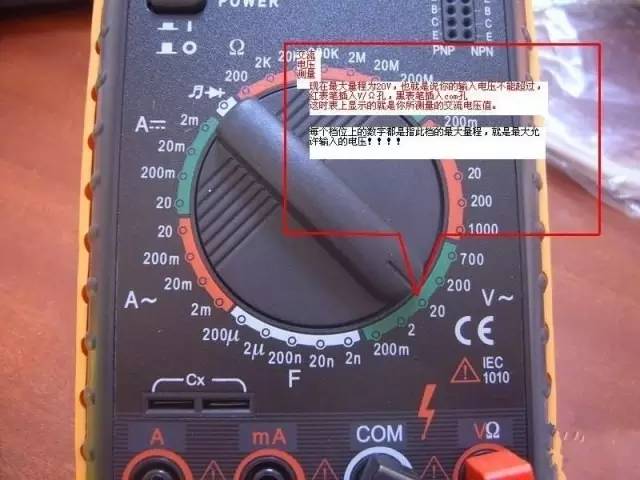
Figure 1
Figure 2 shows five ranges for measuring DC voltage.
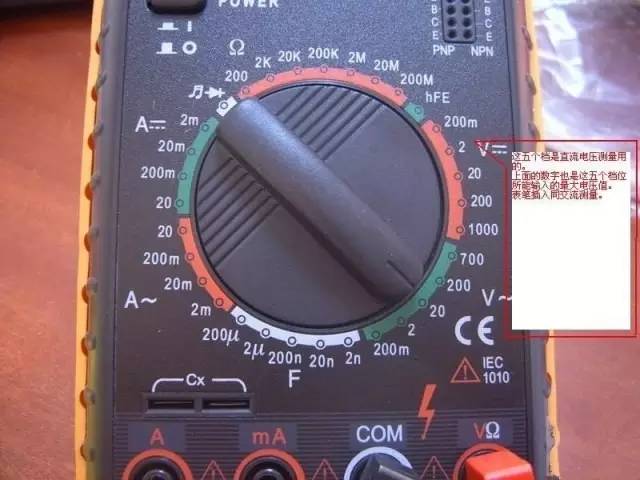
Figure 2
The numbers on the four ranges for DC measurement represent the maximum current values that can pass through, as shown in Figure 3.
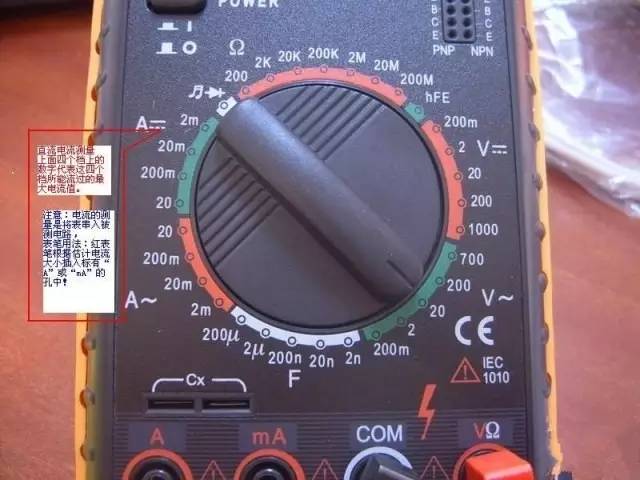
Figure 3
These seven ranges are for measuring resistance values, with the maximum resistance values indicated for each range, as shown in Figure 4.
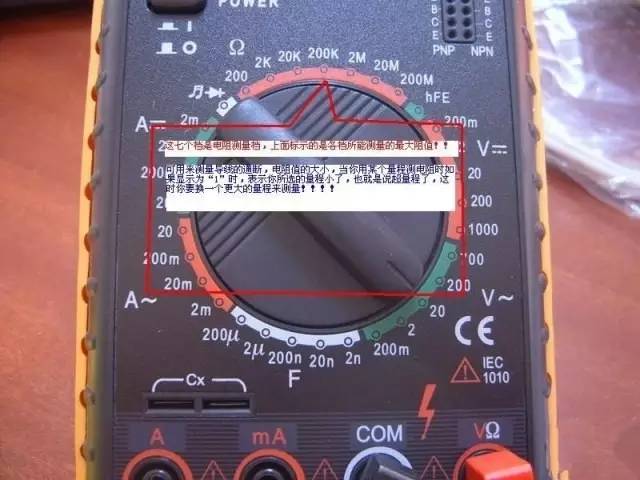
Figure 4
This range is used to measure the good or bad condition of diodes and their continuity, as shown in Figure 5.
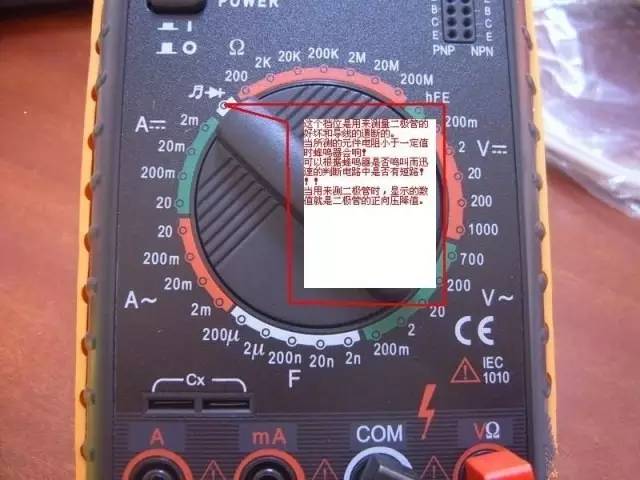
Figure 5
Figure 6 is for measuring capacitance values, with the maximum capacitance values indicated for each range.
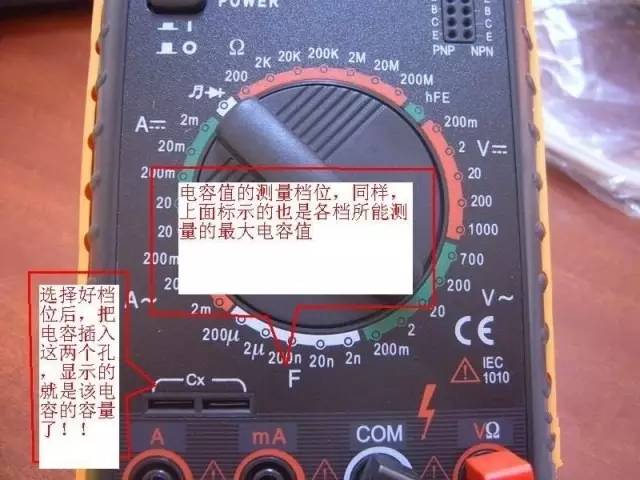
Figure 6
1. Structure of a Multimeter (Model 500)
A multimeter consists of three main parts: the meter head, measuring circuit, and selector switch.
(1) Meter Head
It is a high-sensitivity magnetic electric DC ammeter, and the main performance indicators of the multimeter depend on the performance of the meter head. The sensitivity of the meter head refers to the value of the DC current flowing through the meter head when the pointer deflects to full scale. The smaller this value, the higher the sensitivity of the meter head. The internal resistance when measuring voltage is greater, which improves performance. There are four scale lines on the meter head with the following functions: The first line (from top to bottom) is marked R or Ω, indicating resistance value, read this line when the selector switch is in the ohm range. The second line is marked ∽ and VA, indicating AC and DC voltage and DC current values, read this line when the selector switch is in the AC or DC voltage or DC current range, except for the 10V AC position. The third line is marked 10V, indicating the 10V AC voltage value, read this line when the selector switch is in the AC or DC voltage range at 10V AC. The fourth line is marked dB, indicating audio level.
(2) Measuring Circuit
The measuring circuit is used to convert various measurements into a small DC current suitable for the meter head. It consists of resistors, semiconductor components, and batteries.
It can convert various measurements (such as current, voltage, resistance, etc.), different ranges, through a series of processing (such as rectification, shunting, voltage division, etc.) into a small DC current of a certain limit for measurement by the meter head.
(3) Selector Switch
The selector switch is used to choose different measuring circuits to meet the measurement requirements of different types and ranges. There are generally two selector switches, each marked with different ranges and positions.
2. Symbol Meanings
(1) ∽ indicates AC and DC
(2) V-2.5KV 4000Ω/V indicates that for AC voltage and 2.5KV DC voltage ranges, the sensitivity is 4000Ω/V
(3) A-V-Ω indicates that it can measure current, voltage, and resistance
(4) 45-65-1000Hz indicates that the frequency range is below 1000 Hz, with the standard frequency range being 45-65Hz
(5) 2000Ω/V DC indicates that the sensitivity for the DC range is 2000Ω/V
The symbols on clamp meters and shake meters are similar to the above symbols (other symbols cannot be fully written due to formatting issues).
3. Using a Multimeter
(1) Familiarize yourself with the meanings of the symbols on the dial and the main functions of the knobs and selector switches.
(2) Perform mechanical zeroing.
(3) Select the appropriate range and position on the selector switch based on the type and size of the measurement to find the corresponding scale line.
(4) Choose the position for inserting the probes.
(5) Measuring voltage: When measuring voltage (or current), choose the appropriate range. If a small range is used to measure a large voltage, there is a risk of burning the meter; if a large range is used to measure a small voltage, the pointer will deflect too little to read. The range should be chosen to make the pointer deflect about 2/3 of the full scale. If the size of the voltage to be measured is unknown, start with the highest range and gradually decrease to an appropriate range.
(a) Measuring AC voltage: Set one selector switch to the AC/DC voltage position and the other to the appropriate AC voltage range. Connect the two probes in parallel with the circuit or load being measured.
(b) Measuring DC voltage: Set one selector switch to the AC/DC voltage position and the other to the appropriate DC voltage range, with the “+” probe (red probe) connected to the high potential side and the “-” probe (black probe) connected to the low potential side, allowing current to flow from the “+” probe to the “-” probe. If the probes are connected in reverse, the pointer will deflect in the opposite direction, which can bend the pointer.
(6) Measuring current: To measure DC current, set one selector switch to the DC current position and the other to the appropriate range between 50uA and 500mA. The selection of the current range and reading method is the same as for voltage. Before measuring, the circuit must be disconnected, and the multimeter must be connected in series with the circuit being measured, with current flowing from the red probe to the black probe. If the multimeter is mistakenly connected in parallel with the load, the internal resistance of the meter head is very low, which can cause a short circuit and damage the instrument. The reading method is as follows:
Actual value = Indicated value × Range / Full scale deflection
(7) Measuring resistance: When measuring resistance with a multimeter, follow these steps:
(a) Select the appropriate multiplier range. The ohm scale line of the multimeter is uneven, so the choice of multiplier should make the pointer stop in the less dense part of the scale line, and the closer the pointer is to the middle of the scale, the more accurate the reading. Generally, the pointer should be positioned between 1/3 and 2/3 of the scale.
(b) Ohm zeroing. Before measuring resistance, short-circuit the two probes and adjust the “Ohm (Electrical) zeroing knob” so that the pointer just points to the zero position on the ohm scale line. If the pointer cannot be adjusted to zero, it indicates that the battery voltage is insufficient or there is a problem with the instrument. Additionally, every time the multiplier range is changed, the ohm zeroing should be performed again to ensure measurement accuracy.
(c) Reading: The reading on the meter head multiplied by the multiplier gives the resistance value being measured.
(8) Precautions
(a) When measuring current or voltage, do not change the range while the circuit is live.
(b) When selecting a range, start with a larger range before selecting a smaller one, and try to make the measured value close to the range.
(c) When measuring resistance, do not measure with the circuit live. This is because when measuring resistance, the multimeter is powered by its internal battery, and measuring with the circuit live is equivalent to connecting an additional power source, which may damage the meter head.
(d) After use, set the selector switch to the maximum AC voltage position or to the off position.
4. Digital Multimeter
Nowadays, digital measuring instruments have become mainstream and are replacing analog instruments. Compared to analog instruments, digital instruments have higher sensitivity, accuracy, clear display, strong overload capacity, are easy to carry, and are simpler to use. Below is a brief introduction to the usage and precautions of the VC9802 digital multimeter.
(1) Usage
a. Before use, carefully read the relevant user manual to familiarize yourself with the power switch, range switch, sockets, and the functions of special sockets.
b. Set the power switch to the ON position.
c. Measuring AC and DC voltage: Set the range switch to the appropriate DCV (DC) or ACV (AC) range as needed, insert the red probe into the V/Ω socket, the black probe into the COM socket, and connect the probes in parallel with the circuit being measured. The reading will be displayed.
d. Measuring AC and DC current: Set the range switch to the appropriate DCA (DC) or ACA (AC) range, insert the red probe into the mA socket (for <200mA) or 10A socket (for >200mA), the black probe into the COM socket, and connect the multimeter in series with the circuit being measured. The digital multimeter can automatically display the polarity when measuring DC.
e. Measuring resistance: Set the range switch to the appropriate Ω range, insert the red probe into the V/Ω socket, the black probe into the COM socket. If the resistance value being measured exceeds the maximum value of the selected range, the multimeter will display “1”; at this point, a higher range should be selected. When measuring resistance, the red probe is positive, and the black probe is negative, which is the opposite of the analog multimeter. Therefore, when measuring polarized components such as transistors and electrolytic capacitors, attention must be paid to the polarity of the probes.
(2) Usage Precautions
a. If the size of the voltage or current to be measured cannot be estimated in advance, first set the switch to the highest range and measure once, then gradually reduce the range to an appropriate position as needed. After measuring, set the range switch to the highest voltage range and turn off the power.
b. When full-scale, the meter only displays the digit “1” at the highest position, and all other digits disappear; at this point, a higher range should be selected.
c. When measuring voltage, connect the digital multimeter in parallel with the circuit being measured. When measuring current, connect in series with the circuit being measured; when measuring DC, the polarity does not need to be considered.
d. When the AC voltage range is mistakenly used to measure DC voltage, or the DC voltage range is mistakenly used to measure AC voltage, the display will show “000” or the digits on the lower positions will fluctuate.
e. It is prohibited to change the range when measuring high voltage (above 220V) or large current (above 0.5A) to prevent arcing and burning the switch contacts.
f. When ” ” or “BATT” or “LOW BAT” is displayed, it indicates that the battery voltage is below the operating voltage.
5. Shake Meter
A shake meter, also known as a megohmmeter, is used to measure the insulation resistance and high resistance of the tested equipment. It consists of a hand-crank generator, a meter head, and three terminals (L: line terminal, E: ground terminal, G: shielding terminal).
1) Selection Principles for Shake Meters
(1) Selection of rated voltage levels. In general, for equipment rated below 500V, a shake meter rated at 500V or 1000V should be selected; for equipment rated above 500V, a shake meter rated at 1000V to 2500V should be selected.
(2) Selection of resistance range. The scale line of the shake meter has two small black dots, and the area between the dots is the accurate measurement area. Therefore, when selecting a meter, ensure that the insulation resistance value of the tested equipment falls within the accurate measurement area.
2) Using a Shake Meter
(1) Calibration. Before measuring, perform an open-circuit and short-circuit test on the shake meter to check if it is functioning properly. Open the two connecting wires, crank the handle, and the pointer should point to “∞”; then short the two wires, and the pointer should point to “0”. If both conditions are met, it is good; otherwise, it cannot be used.
(2) Disconnect the tested equipment and lines; for large capacitive devices, also discharge them.
(3) Select a shake meter with a voltage level that meets the specifications.
(4) When measuring insulation resistance, generally use only the “L” and “E” terminals. However, when measuring the insulation resistance of cables to ground or when leakage current of the tested equipment is severe, use the “G” terminal and connect it to the shielding layer or casing. Once the connections are made, turn the crank handle clockwise, increasing speed from slow to fast. When the speed reaches about 120 RPM (for the ZC-25 model), maintain a uniform speed, read the value after one minute, and read while cranking; do not stop to read.
(5) Discharge the lines after reading. After reading, slowly crank while disconnecting the lines, then discharge the tested equipment. The discharge method is to remove the ground wire used during measurement from the shake meter and short it with the tested equipment (not discharging the shake meter).
3) Precautions
(1) It is prohibited to measure insulation resistance during thunderstorms or near high-voltage equipment; measurements can only be made when the equipment is not energized and free from induced voltage.
(2) During the shaking measurement process, no one should work on the tested equipment.
(3) The shake meter wires should not be twisted together; they should be kept separate.
(4) Do not touch the shake meter or the tested equipment until the shake meter has stopped turning or the tested equipment has been discharged. When disconnecting the wires, do not touch the metal parts of the leads.
(5) At the end of the measurement, discharge large capacitive devices.
(6) Regularly verify its accuracy.
6. Clamp Meter
A clamp meter is an instrument used to measure the current in electrical lines while they are in operation, allowing current measurement without disconnecting the circuit.
1) Structure and Principle
A clamp meter essentially consists of a current transformer, a clamp wrench, and a rectifying magnetic electric meter with reactive force.
2) Usage
(1) Perform mechanical zeroing before measurement.
(2) Choose the appropriate range, starting with a larger range before selecting a smaller one or estimating based on the nameplate value.
(3) When using the smallest range for measurement, if the reading is not obvious, you can wrap the tested wire several times, using the number of turns at the center of the clamp as a reference; the reading = indicated value × range / full scale deflection × number of turns.
(4) During measurement, ensure that the tested wire is centered in the clamp and that the clamp is tightly closed to reduce errors.
(5) After measurement, set the selector switch to the highest range.
3) Precautions
(1) The voltage of the tested line must be lower than the rated voltage of the clamp meter.
(2) When measuring the current of high-voltage lines, wear insulated gloves, insulated shoes, and stand on an insulated mat.
(3) The clamp must be tightly closed; do not change the range while energized.
End
Source: Chongqing Construction Training
2017 Most Popular Engineering WeChat Account Recommendations
★ Long press the QR code and select “Identify the QR code in the image” to follow.
Engineering Alliance
WeChat ID: xuezaojia123
Introduction:A great place for engineers to communicate and improve, with quality technical articles updated daily!

▲ Long press the QR code to identify and follow

Engineering Comprehensive
WeChat ID: zaojia369
Introduction:Daily updates of quality articles on engineering!

▲ Long press the QR code to identify and follow

Engineering Platform
WeChat ID: gcgc100
Introduction:A platform for engineers to communicate, learn, and publish engineering information
 ▲ Long press the QR code to identify and follow
▲ Long press the QR code to identify and follow

Engineering Construction Technology
WeChat ID: gmz100
Introduction:Providing you with engineering construction knowledge, information, and news!

▲ Long press the QR code to identify and follow

Engineering Cost
WeChat ID: zaojia360
Introduction: A platform for learning and exchanging knowledge about construction engineering costs

▲ Long press the QR code to identify and follow

Engineering Materials
WeChat ID: xuezaojia365
Introduction: Sharing of professional standards, drawings, and engineering study materials
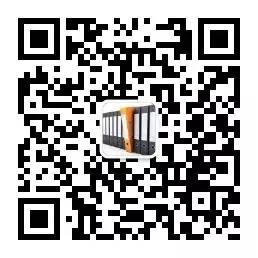
▲ Long press the QR code to identify and follow

Inspirational Journey
WeChat ID: lizhi567895
Introduction: We do not want mindless platitudes, but we need a spirit of hard work that lights up our lives!

▲ Long press the QR code to identify and follow

